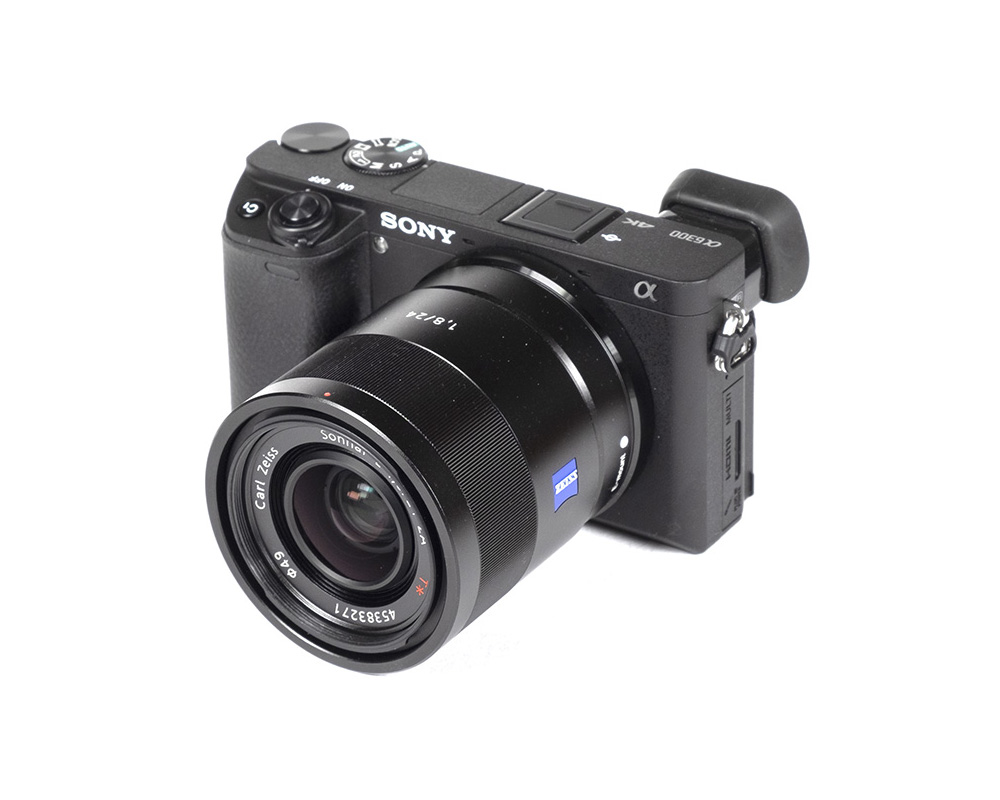Introduction
We have to admit that there was a rather embarrassing gap in our list of Sony E-mount lens reviews – the Zeiss Sonnar T* 24mm f/1.8 ZA. It has been around for ages and it’s probably what you’d call a lighthouse product in Sony’s APS-C lens lineup. Lighthouse products are not only special regarding their characteristics but also their price tag. The Zeiss lens is available for just under 1000EUR/USD which is probably beyond what most APS-C users would be willing to pay. So let’s see what you would get for your hard-earned bucks.
The first thing that you’ll notice is the size of the lens (below compared to the Sony FE 24mm f/1.4 GM). Reads – it’s small and very light-weight and as such perfectly aligned to Sony’s APS-C cameras. The build quality is excellent thanks to a tightly assembled all-metal body. That being said – there’s no word about weather sealing in the spec sheet. Our test sample didn’t come with a lens hood but normally a petal-shaped hood is part of the package.

The AF is very fast and essentially noiseless. Typical for most E-mount lenses, manual focusing works by wire.
| Specifications | |
|---|---|
| Optical construction | 8 elements in 7 groups inc. 2x aspherical & 1x ED elements |
| Number of aperture blades | 7 (rounded) |
| min. focus distance | 0.16m (max. magnification 1:4) |
| Dimensions | 63×65.5mm |
| Weight | 225g |
| Filter size | 49mm |
| Hood | petal-shaped (bayonet mount, supplied) |
| Other features | – |
| Mount | Sony E (APS-C) |
Distortion
Unsurprisingly, images are essentially free of distortions with activated image auto-correction. When looking into RAW images, you can notice a slight pincushion distortion. It’s not dramatic but the type is a little unusual for such a lens. You’d normally expect to see a barrel distortion from wide-angle lenses.
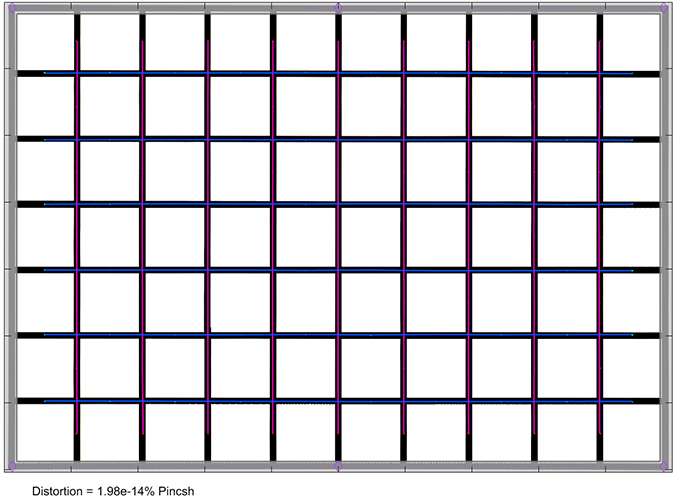

Vignetting
Zeiss has an old enemy and that enemy is vignetting. This also applies here. At f/1.8, the light-falloff is beyond the scale that we are usually using for APS-C format tests (~2.1EV). Stopping-down helps,
of course, but there’s no glory here even at f/4. Thus image auto-correction has to come to the rescue. When activated, the vignetting is reasonably low even at a fully open aperture (at cost of increase corner noise due to the brightness amplification). The issue is mostly negligible from f/4 onward in this case.
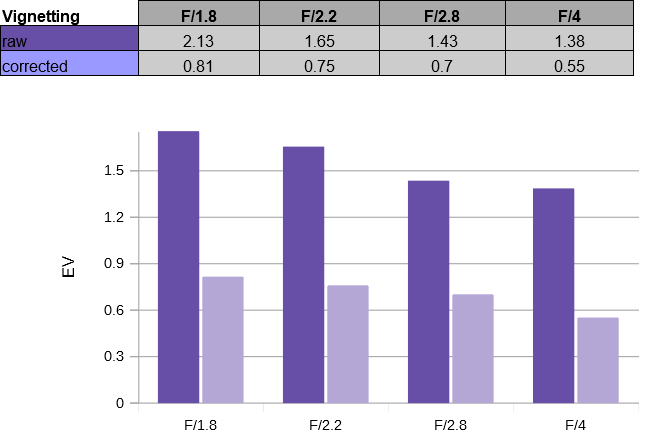
MTF (resolution)
The resolution characteristic of the Zeiss Sonnar T* 24mm f/1.8 ZA is excellent. The center quality is very high at f/1.8 already and the outer image field is pretty good at least. Stopping down lifts the quality till reaching its best spot around the f/4 mark. Images are tack sharp here. Diffraction is limiting the performance at smaller aperture settings but f/11 remains usable.
While the performance is superb, the same can’t be said about the centering quality of the tested sample. While we haven’t seen any relevant issues with Sony’s full format lenses so far, the same can’t be said about most of their APS-C lenses. Maybe we are just unlucky but the outlier rate has been very high for us here. The above chart represents the best corner of the image field. Such an approach
is usually close to a “normal” lens (if there is such a thing in Sony E-mount land).
Please note that the MTF results are not directly comparable across the different systems!
Below is a simplified summary of the formal findings. The chart shows line widths per picture height (LW/PH) which can be taken as a measure for sharpness. If you want to know more about the MTF50 figures you may check out the corresponding Imatest Explanations
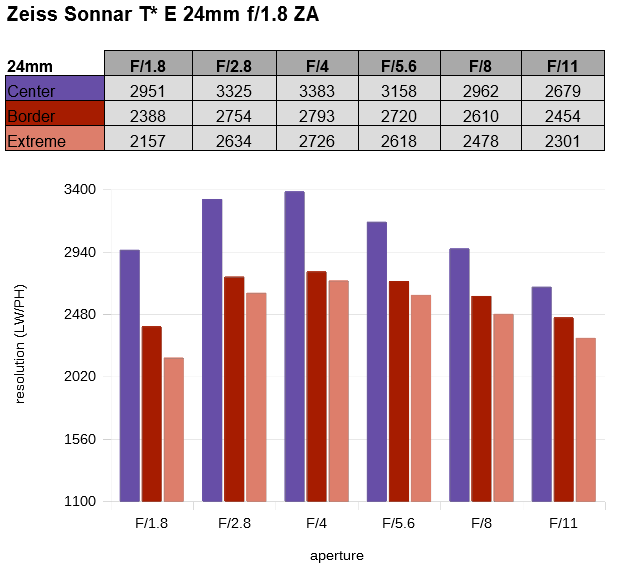
Chromatic Aberrations (CAs)
Lateral CAs (color shadows at contrast transitions) are low with an average CA pixel width of around 0.6px at the image borders.

Bokeh
The “bokeh” is not about the sheer capability to produce a shallow depth-of-field. Even the worst lenses can produce a silky blur at close focus distances. The bokeh is about the quality of the blur with respect to the rendering of out-of-focus highlights as well as the softness at high-contrast transitions.
Sony emphasizes the high quality of the bokeh (out-of-focus blur). However, the preconditions aren’t that good here. The Zeiss lens relies on 2 aspherical elements and that’s usually not a good sign in this respect. As you may spot below, out-of-focus highlights have a rather busy inner substructure. Stopping down emphasizes the effect. Furthermore, the aperture shape is getting distinctively edgy from f/2.8 onward which isn’t overly pleasant – this originates in the comparatively small number of aperture blades (7).
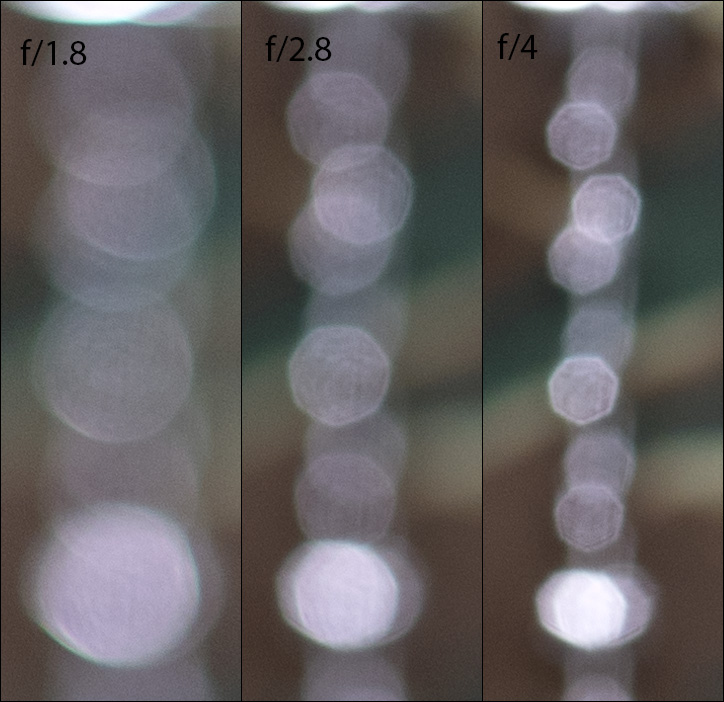
The general rendition of out-of-focus areas is good in the image background (to the right below) although the blur is somewhat asymmetrical as you can see in the sample crop below. There’s also a visible greenish halo (axial CAs) visible here. The foreground blur (to the left) is somewhat harsher.

A more positive aspect is the rendering of the highlight discs towards the borders/corners. Typically, the shape of the discs deteriorates substantially – often into “cat eyes”. However, the Sony lens is at least capable of maintaining an ellipsoid shape at f/1.8. As usual, stopping down corrects the shape a little albeit not perfectly.


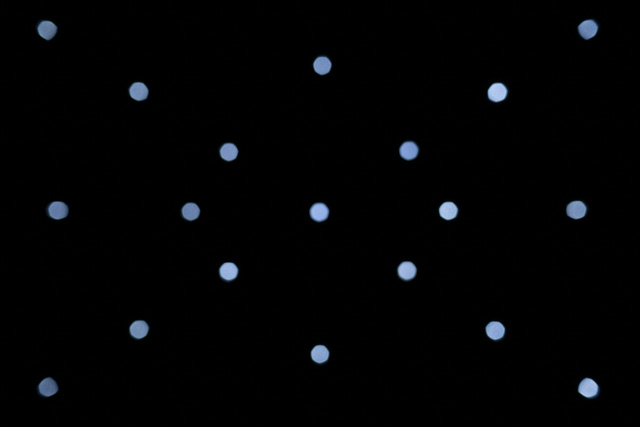
Competition
There are probably two lenses that are directly competing with the Zeiss Sonnar T* E 24mm f/1.8 ZA – the Sony 24mm f/1.4 GM (center below) and Zeiss Batis 25mm f/2 (to the right). Both are newer,
full-format designs. The Sony GM lens is arguably not only the fastest but also the best of the bunch. You can also expect the Batis to be slightly better than the 24mm f/1.8 ZA. However … both lenses are substantially bigger and also more expensive.

Visual comparison courtesy of camerasize.com.
The Zeiss Sonnar T* E 24mm f/1.8 ZA is a great little lens - if you can get a well-centered sample at least. In terms of resolution, it delivers everything that you expect from such a high-priced lens. It's already very usable at f/1.8 and razor-sharp at optimal aperture settings. Lateral CAs are low. A Zeiss-weakness is, once again, vignetting so auto-correction is a good idea here. Auto-correction also helps to eliminate the slight pincushion distortion that is present in RAW mode. The bokeh is a bit sub-par but this applies to most wide-angle lenses.
The build quality is top-notch in terms of materials and smoothness of the focus ring. However, there is no weather-sealing which is really a pity at this price point. It's worth noting that the lens can focus down to an object magnification of 1:4 (0.16m) which is interesting for dramatic close-ups.
If you want a high-performance, yet low-profile wide-angle lens for your APS-C Sony camera, the Zeiss is an obvious choice. The pricing is a bit of a problem though. Sony has always charged a premium for Zeiss-branded lenses but at close to 1000USD/EUR it's really over the top here. For comparison - the Sigma 16mm f/1.4 DN DC sells for just 400USD/EUR and that's an even wider and faster lens. And if you can live with something bigger, the new Sony 24mm f/1.4 GM is probably the better and more flexible alternative.
-
Optical Quality
-
Build Quality
-
Price / Performance


